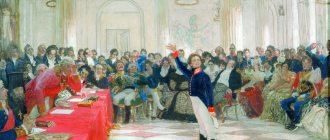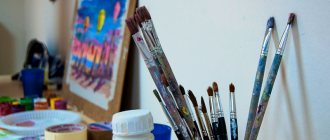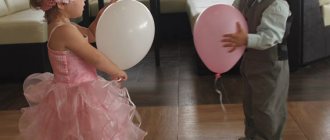Teaching preschoolers to read online in a playful way
Hello, here are online trainings on teaching reading to your children. The trainings are free. I, like you, agree with the thesis that the Internet makes everything free. Therefore, I tried to make high-quality exercises for you that helped my children and I hope that they will help yours too. I know that you don’t care how I get married or how I earn money. Previous versions of the site were stolen and posted online. I worked on them for many months... So I decided to immediately provide free access. You are not thinking about me, but about your children - and rightly so. Some of you are wondering why your daughter or son knows letters but cannot read. I know how to solve your problem easily and simply.
Click and start practicing letters, syllables and word reading
On a tablet, on a computer, on a phone
Educate your child in a modern way!
A child masters a computer faster than he learns to speak. “Research by antivirus company AVG found that children learn computer and electronic device skills earlier and more easily than traditional everyday skills.” “69%, 63% and 58% of children under five years old, respectively, can operate a computer mouse, turn the computer on and off, and play simple games on a PC. A quarter of children of the same age are able to launch an Internet browser on their own, and 16% of kids already know how to browse websites and follow links.” This means that interactive exercises are more readily accepted by children than reading books.
Therefore, children do not want to study using boring paper manuals.
When can you start teaching your child to read?
There are several opinions about when you can start teaching your child to read. Some experts believe that you can start certain work, for example, showing Doman cards (we will talk about them and other methods in the second lesson), when the baby reaches six months of age, while others believe that it is best to start at 3-4 years , and precisely from the ABC book. However, all teachers agree on one thing: no teaching of reading is completely unacceptable and impossible until the child has mastered speech skills. If, around the age of 3-4, the child begins to take an active interest in books, it is not only possible, but also necessary to begin learning to read.
It is also worth noting that if you show restlessness and indifference to printed materials, before learning, you should understand how to arouse the child’s interest in reading. We will touch on this issue in more detail in a separate lesson, but we will still say that in solving this problem, parents will be helped by an incredible selection of books that stand out, in addition to brightness and colorfulness, by the presence of many moving elements and even sound. Thanks to this, reading becomes not just an interesting activity for children, but also an exciting game. At the initial stage, any book serves not so much as a source of knowledge, but as a way to become familiar with the reading process itself.
Continuing the conversation on the topic of a child’s readiness to read, it can be determined by several criteria:
- Firstly, the baby has already formed speech, and he is able to pronounce words and sentences, as well as compose at least small coherent stories
- Secondly, the child does not have speech therapy disorders, and this applies to both incorrect pronunciation and violations of the melody and tempo and rhythm of speech
- Thirdly, the baby is able to navigate normally in space, and does not confuse the concepts of “right”, “left”, “down” and “up” with each other.
- Fourthly, the child has sufficiently developed phonemic hearing, i.e. he can easily recognize sounds in different parts of words
If problems are observed with any of the above, you should begin to eliminate them - spend some time working on the issues causing difficulty, visit a speech therapist, neurologist, etc. If everything is in order (or after the problems have been eliminated), you can move on to learning to read.
More effective than in development centers
As numerous experience shows, preschool children cannot concentrate on a task for more than 5 minutes. Afterwards they need rest. Let’s say the cost of classes at a development center is 500 rubles. 10 people attend classes. Classes last 45 minutes. In total, in terms of time, it turns out that the teacher spends 5 minutes on each child (and does he spend it at all?) - not every development center installs video cameras and films the lesson process.
Ask yourself questions:
- How your baby's progress is monitored
- How individual is the approach in development centers?
- How quickly do you learn letters?
Our trainings do not offer miracles; we do not claim that a child will begin to read through a lesson. But what we can guarantee is an individual approach. The program has a dictionary of 900 words and it is being updated. Therefore, you can choose words for any warehouse.
A few words about proper reading teaching
The presented question worries, perhaps, every parent. And the first answer to it will be the traditional method, which boils down to daily monotonous exercises in reading the primer. But this option is not very effective, because the child almost always becomes bored, he quickly gets tired and tired. Plus, he doesn’t learn to read thoughtfully at all. Of course, the baby will master some skills and knowledge, but calling this a good way of sensory-emotional development, knowledge of the world around us and one’s place in it is a stretch. In order for the process to become exciting and creative, so that it arouses interest in the child, so that the reading skill is mastered effectively, it is necessary to use other methods (we have devoted separate lessons of our course to such methods, and for now we will not focus on them).
Before you start learning to read and use any methods, you must learn the basic rules that you should rely on in your activities. They can be called the basis of this entire process. Although small deviations are allowed, it is still recommended to adhere to all the rules, otherwise the child will master the reading skill less effectively, which should not be allowed under any circumstances.
We save your time and money
Usually, the mother of a preschooler buys reading instructional goods for 3,0000 -7,000 rubles. A new benefit is purchased immediately after it becomes clear that the previous purchase was ineffective. No one is in a hurry to return money for ineffective classes or low-quality books. In the case of development centers, the situation is generally paradoxical. You cannot check the level of knowledge of teachers, you cannot interfere in the course of training, as a rule, you kiss closed doors and wait in the corridor outside the training class.
Preschool alphabet for children
Modern parents have a wide range of materials to choose from for learning letters.
Among others, it is important to highlight:
- electronic alphabet. Provided in the form of a large poster with a built-in voice recorder. It's bright, interesting and educational. The only downside is that the voice recorder records the sound of the letter, but not the sound (not “m”, but “em”);
- alphabet with stickers. They are very popular among children. Having determined the letter on the page by objects, you need to paste the desired letter. You can make such an alphabet yourself;
- learning letters on video alphabet. Modern trends allow children to watch not just cartoons, but educational cartoons, with the help of which they can build an entire educational program;
- magnetic alphabets;
- educational games: lotto, mosaic, cubes.
Among the many printed alphabets we can highlight:
A. Benoit “The ABC in Pictures” is one of the oldest publications. Its author is a famous Russian writer and historian. The alphabet was first seen in 1904.
The ABC of Alexandre Benois is considered the source of all subsequent illustrated publications.
In addition to letters, the book also contains poems by poets of the Silver Age.
B. Zakhoder and his “Shaggy ABC”. Parents of children may still remember this publication from their childhood. Since the release of the primer to the masses, the book has been reprinted by more than one publishing house:
Soviet edition.
Publishing house "Onyx", 2010.
Publishing house "Samovar", 2013.
Wonderful alphabet by Joseph Brodsky “Working ABC”. The ABC is notable not only for the poems written by the young Brodsky, but also for the illustrations of the talented artist Igor Oleinikov. The artist tried to depict several objects with a given letter that the children had to find.
“Working ABC”, publishing house “Akvarel”.
Parents especially note the effectiveness of Nadezhda Zhukova’s alphabet:
ABC N. Zhukova
Tutors recommend us
Learn Russian by playing
- Currently, the program knows more than 900 Russian words. All words are voiced and divided into syllables.
- Because there is a lot of material. So many. That is, it was decided to use a minimum of animation, characters and voice acting were also practically excluded - it interferes in the case of intensive work with children. As trivial as it may sound, memorization comes through repetition of the same material. The more often the material is repeated, the more successful the memorization is.
- Some of the material is paid.
- The program was designed primarily by a programmer - a father of two children. I will say frankly that I do not have extensive experience interacting with other children and have scant experience in this area. Based on my experience, I came to the conclusion that it is necessary to remove all distractions when studying. I also realized that fathers don’t have much time for activities. Maybe 5-10 minutes a day. During this time you need to repeat the maximum. Children quickly lose interest in boring repetition and are more inclined to absorb worthless cartoons, so they look forward to the end of the lesson.
- It is recommended to do the programs for 10-15 minutes a day. It is best if you remember the address of the page on the social network and return to classes once a day. There is a lot of material. It will be enough for 7-30 days of classes.
- If you have a question for me, then write or on the social network https://vk.com/abcolut
- I am looking for contacts with methodologists in the field of children's education to create training in other areas.
Reading words without knowing all the letters is easy!
Teaching preschool children to read in a playful way. 900 words for children to read and teach reading. We teach children to read by word order online for free. Preparing children for school. Development of a strong and self-sufficient personality. Development of reading speed in preschool children. Does the child know letters? Doesn't it seem boring to repeat the same sounds? Try to do this in a playful way.
Have you ever wondered why your child cannot read, although he knows all the letters? This game allows you to teach reading even before the child has learned to speak. We decided to make a website for teaching children to read because for a long time we could not understand why my daughter could not learn to read. My daughter added the letters Me + A + Me + A and could not get the word MOTHER. How much we got on each other's nerves! But it turns out that you need to read not by letters, but by combinations of letters. MA + MA (by warehouses). This site talks about how to easily and simply teach a child to read and have fun at the same time. The games presented on this site were developed by my husband - play for fun and tell your friends about the site, most likely their children are experiencing the same difficulties. as is yours.
New games
- Math training - add three and get the result
- Read the word and assemble it from letters
- Multiplication table training
- Teaching English to schoolchildren using speaking cards
- 100 most common mistakes in Russian
Teaching reading to children 3,4,5,6 years old in a playful way.
Introduction to letters, alphabet, correct pronunciation, simple texts for reading syllables (skaladas)
;
Teaching letters
;
Copybooks
;
Reading texts
;
English; Articles; Speech therapy; Memory; Music;Drawing;Counting; Attention;Imagination;
How a child is formed. general information
Here, as you should understand, we will present only general information, because... it will be quite enough.
So, starting from the early stages of pregnancy and ending at the age of three, the first functional block of the baby’s brain is formed, which is responsible for his bodily, cognitive and emotional perception.
From three to five to eight years, the formation of the second functional block of the brain occurs, which controls the five senses - touch, taste, smell, hearing and vision.
As for conscious mental activity, it develops in a period of approximately seven to fifteen years.
It should be borne in mind that the formation of functional brain blocks is a sequential process. Any attempt by a parent to “skip” any stage negatively affects the natural development of the child, because unnatural “adjustments” are made to it. The insidiousness of the consequences lies in the fact that, quite likely, they will not be felt immediately, but over the years. Subsequently, an already matured child may develop problems, expressed not only in speech disorders, neuroses, motor disturbances, etc., but also in difficulties in relationships with other people.
Based on this, you need to start teaching your child to read at a certain time.
Making up words
For this stage, cut cards with syllables will be useful. At first, take 3-4 pieces, then you can have more. Give the task to compose words from the cards received; it is better if there are several options. For example, on the table are the syllables MA, RA, ZI, PO. Let him make up the words: WINTER, TIME, FRAME.
The next stage is composing words with closed syllables. You will need separate letters and cards with open syllables. For example, MA, PA, SO and the letters on the cards K, F, M. You get the following set: MAC, SOK, PAGE, COM.
After 2-3 lessons, offer to compose words of several syllables. Choose simple lexemes: HOUSE, GRASS, SHOVEL.
After composing words on your own, you can move on to studying books with short texts. First, the baby reads individual words with one syllable, then with two or three. There is no need to rush, scold, or suggest.
Pronunciation
Now that you have already taught how to read the first words syllable by syllable, carefully watch how your child pronounces them. And correct any inaccuracies immediately, do not leave it for later. It’s easier to repeat everything a little more times from the very beginning than to then purposefully and not always successfully eliminate errors.
To develop reading skills
- Sounds in a circle. Children need to come up with words that begin with the last letter of the previous word. For example, window-OSA-Album, etc.
- Reading with adults. The book is placed on the table so that the text is visible to the parent and baby. When one reads, the other follows. Stop unexpectedly and ask to continue. Attention and visual memory develop.
- We are looking for an error. Parents give the child a text with errors and catches. For example, KoSa ate all the grass in the field. Sol(b) was spilled onto the table. The child’s task is to find and correct the mistake while reading.
- Who's speaking? Animal toys and clean leaves will come in handy. Together with your child, sign the cards: Mee, Oink, Mu, etc. Empty will substitute the required syllable for the toys and read.
Educational games and entertainment
To make learning the material fun and easy, there are several simple but effective techniques. We have already mentioned some of them above:
- Magnetic letters on a board or refrigerator where you can always practice a new skill.
- Continue with the parent, dad or mom says the beginning, and the baby finishes. This can be done either orally or using special cards.
- Associations. Show a clear example of a particular letter and ask them to name the correct word.
Texts by syllables for children starting to read
Important: If your child is learning to read, the font size should be easy to read and understandable for a certain age.
Use the following texts by syllables for children starting to read:
Texts by syllables for children starting to read
Texts by syllables for reading
Reading texts
Possible difficulties
There are several problems that all parents face to one degree or another. It’s not difficult to fix them, you just need to pay attention and practice a little longer.
- Merging of sounds.
The child cannot read a syllable together and pronounces the letters separately. There is a simple visual way: draw a line between two letters and say that they seem to be striving for each other. Repeat, practice the sound. - Regressions.
Although the baby is reading, his eyes involuntarily return back to what has already been covered. In this case, slow down the pace of your studies and go through the material a little longer. - Thinking through.
This occurs even among schoolchildren, but it appears at a time when the child is just learning to read syllables at home. A boy or girl pronounces the beginning of a word correctly, but ends it incorrectly. This can only be corrected by constantly pointing out errors.
Exercises to develop attention
When the child learns to put words together without much effort, you should complicate the task for him.
- Compose a word by missing one letter. The child must find the missing item. To do this, he must carefully read the word syllable by syllable. Sometimes children try to guess what the word is in front of them. And because of haste and inattention, they do not see the mistake. For example: ta-re-ka (plate). A child may not notice the missing letter “l” if he guesses the whole word without reading it. His attention should be drawn to the need to read each syllable as it actually looks, and not in his imagination.
- The reverse task is an extra letter. The process is similar. Carefully sing all the syllables, as a result of which the error will be revealed. Words must have no more than three syllables. And it’s better to choose a consonant as the extra letter. It is easier to detect because the child will try to associate the vowel with the subsequent letter. But the task is also to ensure that the child is satisfied with his work. Otherwise, learning will quickly turn into torture. For example: ken-zhgu-ru (kangaroo). If you read it carefully, the extra consonant will hurt your ear and will immediately show up.
- Similar words. Here the child should be asked to read words that differ by only one letter. Kit-cat, steam-heat, forest-fox. Pay attention to the change in the meaning of the word from replacing one letter with another. You can use pictures with mixed up inscriptions. Write “whale” under the image of the cat. And focus the task on reading, and not on the drawing.
Such tasks perfectly train perseverance, attention, concentration and the ability to carry out what is set in the task. These qualities are also important for further understanding the meaning of what is read, and will be useful in school classes.
Which alphabet is better?
When approaching the issue of choice, it is difficult to choose a specific alphabet. Each parent must determine the appropriate teaching method individually, taking into account the capabilities and interests of their child.
Playful learning methods, and therefore the corresponding alphabet, are suitable for mobile and active children.
For more diligent children, you can choose a talking poster, magnets, or a book.
Curious children should choose interesting alphabet books in which to look for answers.
The problem of motivation
Preschoolers and first graders don't really have many opportunities to develop a love for reading. After all, at the moment the most interesting books are not yet available to them, as they are too voluminous. What to do in this case?
- Read aloud with your child
. First, agree that you read a page, and the child one sentence, gradually the volume of what you and the child read should be equal. - Try to find an interesting book with a small amount of text
, it could be: a book of poetry, a children's encyclopedia, comics, or even a collection of jokes. - Use external motivation, such as a game.
- The book you offer your child to read should not be voluminous with small print and no pictures. The text needs to be given to the baby “in portions”.
- Reading should not become a punishment
; there is no need to encourage it, just as there is no need to punish it. - Try to choose works based on which films or cartoons were made: first read the book, and then watch the film
, paying attention to the fact that not all interesting moments from the book were filmed and, in general, the book is much more interesting than the film. - Read for yourself
. The child should see that parents enjoy reading.
In conclusion, we will say that not all children are able to learn to read correctly and without errors without the help of a specialist. There is such a problem as dyslexia, which we will talk about in the following articles.
Getting to know sounds
Before you get acquainted with the appearance of the letters, tell your child about the sounds. Divide them into several groups. For example, vowels - they can be sung, voiced sounds - show them using the example of sounds of nature (thunder rumbles, a tiger growls), unvoiced ones relate to quiet, non-melodic sounds (shhhh, puff).
At this stage, it is important to form an image, a phonetic shell of letters.
This will help the child perform syllabic and phonemic analysis of words at school.
On a note! To distinguish between voiced and deaf when speaking, use your fingers to your throat. When pronouncing R, D, M and other voiced consonants, there will be vibration under the fingers. When pronouncing deaf words (SH, P, S, etc.) there is no vibration.
"Catch the Sound"
We tell the child words, and he should clap his hands when he hears a certain sound (for example, [l]).
Books
During the homeschooling process, parents will need methodological support. To do this, you can use the following manuals:
- O. Uzorova “Quick learning to read.”
- N. S. Zhukova “Primer”.
- I. Brodsky “Working ABC”.
- G. R. Lazgdyn “Speech therapy alphabet”.
- Kozhevnikova A. Yu. “Battlers.”
- Teacher's aids from the set for Zaitsev's cubes and Doman's cards.








